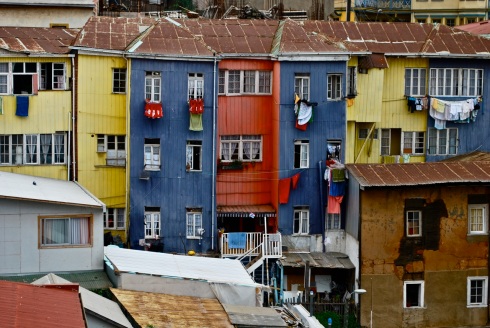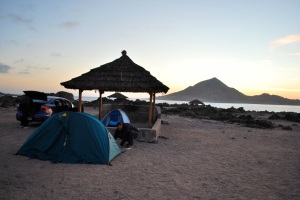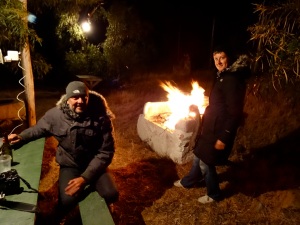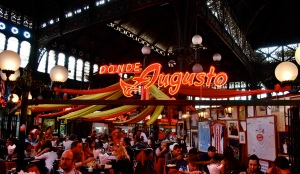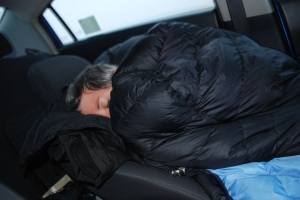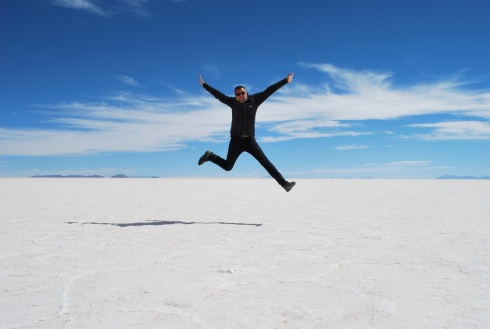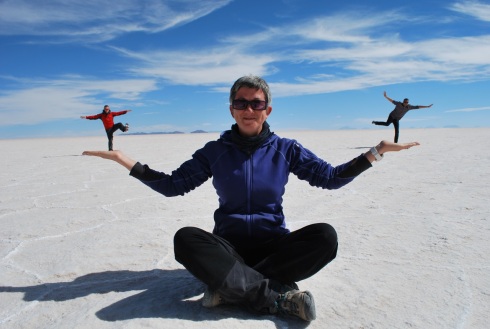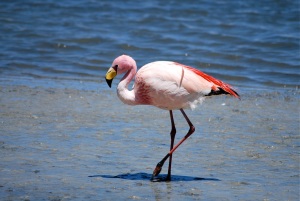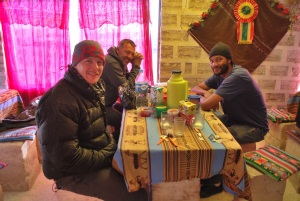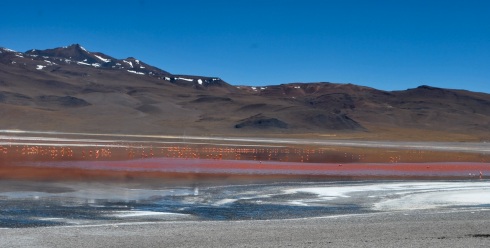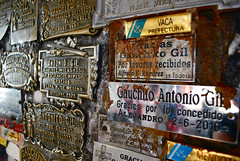Jupapina, nr Mallasa, Bolivia
[by Paula]
We spent a day trying to decide where to go for the last portion of my brother’s visit. We could still make it to Peru for some trekking? Maybe pop over to Argentina?
After Derek left, Jeremy I were either going to be scooting back up north to Ecuador to collect our van (remember the van?), or heading directly to Bolivia to begin a voluntary work placement we’d set up, which meant the most illogical thing to do would be to head south again.
So that’s exactly what we did.
Let’s hire another car, we said, and drive south to Santiago – it’s only 1,670 kilometres (1,012 miles) each way!
We were getting to know this Atacama Desert road pretty well. A bit under-prepared on the provisions, we pulled into a little roadside posada for dinner before pushing on for our second visit to Pan de Azucar national park. We pitched our tents as the sun set behind the island, then settled in for a night of, well, not very much. So disorganised had we been that we only had one can of beer and a handful of sweets for entertainment. But it’s amazing what you can do with nothing. We trawled the site for wood, lit a fire and shared the can. Rock ‘n roll!
Then Derek did his best Bear Grylls impersonation and showed us you can boil water in a paper (yes, paper) cup on the fire. Most exciting cup of coffee I’ve ever had! If we can make a cuppa from nothing, we can survive anything.
We left early the next morning and pulled into Chañaral for one of Chile’s best any-time-of-the-day snacks, a hulking great steak and avocado sandwich. Happy 14th wedding anniversary to us!
Another long day of driving, and several gas station coffees later, we made it well south of La Serena and into new territory for Jeremy and me. We had high hopes for a campsite called Termas de Socos, which reportedly had natural hot thermal waters. We pulled into an empty, very locked, campsite. Bugger. We took our unwashed, rather unpleasant looking, selves into the very posh hotel next door to ask if they could help. They phoned the campsite owner who came down and opened it for us – an entire, massive campsite to ourselves! The ‘thermal pool’ was empty but the bonus was that the owner also ran a restaurant just up the road.
We pitched the tents and headed straight up there for a totally delicious – and cheap – dinner of roasted goat and ribs with the most orgasmic mashed potato in history.
Back at the tents, Derek went into full pyromaniac mode with the campfire, and we willingly colluded. The music was cranked up, and the more we drank the more outrageous the fire got. Luckily no one was around to hear the singing.
On our wedding day I’m not sure what we thought we’d be doing 14 years hence, but it probably wasn’t that.
Next morning we found the perfect antidote to a hangover and a few days without a shower. The very posh hotel next door rented out natural hot baths – bingo! We each got an individual room with a huge bath and unlimited hot water. Ahhhhhhh.
Three squeaky clean, slightly wrinkled, bodies climbed back into the car and headed for Valparaiso. We were amazed we easily found our B&B in the city’s crooked, windy, unbelievably steep streets. From our room we had a fantastic view over the bay.
We spent three nights in this kooky, artsy city which is part grimy and edgy, part pretty and funky. One of the most remarkable things about it is that seemingly the entire city has been, willingly, given over to graffiti art, murals and brightly painted buildings, which makes for some great aimless street-wandering.
Derek and I took the ascensor (while Jeremy took his vertigo for a steep walk) up to the Cerros Concepcion and Alegre district, where we shopped, then ate the thickest seafood chowder known to man.
We visited the late, uber-famous, Chilean poet/activist/politician Pablo Neruda’s fabulous home and mooched round the city’s ornate cemetery.
Having not quite adjusted to Chile’s late night culture (band starts at midnight, what?!) we heroically managed to prop our eyelids open to watch some sublime live music – the mesmerising, accordion-wielding, gypsy-jazz-salsa singer Pascuala Ilabaca and her band Fauna.
Derek’s final stop in Santiago was brief, but not too brief to visit the famous Mercado Central, a vast and chaotic emporium of fish sellers and fish restaurants. We sampled a few dishes – king fish, eel and merluza – while watching several of Santiago’s upper echelons order king crabs at well over US$100 a go. The waiters delivered them with a flourish, as everyone watched and took photos, which was presumably the reaction they were hoping for! We left enough of a gap before scoffing ceviche and one of the best tres leches cakes ever encountered, at bar The Clinic – the official bar of Chile’s political magazine of the same name.
The following day was a repeat of That Horrible Goodbye, as Derek took off back to Scotland and his wife Fiona and kids Skye and Finn – who had kindly loaned him to us for a while. Hasta luego hermano!
We’d been hoping we could dash back to Ecuador, collect the van, and make it (almost) on time to Bolivia, for the work project we’d organised. But while the mechanic had managed to source and install a manual gearbox in the van, there was still an issue with the computer understanding what the heck was going on, and a part had been ordered from Germany to try to resolve it.
We didn’t see the point in going back to Ecuador to wait around, when we had something great lined up in Bolivia, so we decided to head straight there and worry about the van once it was fully repaired.
First we had to return the hire car in Calama. We bombed it back up north in a long two days. The journey included an epic search for somewhere to camp or lodge near Antofagasta, on the coast. All campsites turned out to be closed or too rough-looking to contemplate. We searched nearby coastal ‘resorts’ which turned out to be more of those creepy half-abandoned encampments we’d seen before. When we enquired about camping or staying in cabins were told everything was ‘closed for maintenance’.
All lodgings in the town of Mejillones were booked out with miners – we almost got desperate enough to ask in a dire-looking dosshouse. But one look at the way the plastic ‘garden’ furniture was chained to the fence outside gave us pause to reconsider.
We found a posh hotel a few miles away, parked on the edge of their property and slept in the car. Oh what crusties we have become.
Things got creepier the next day when we took a different route up the coast and, in the early morning fog, came across a baby cemetery right on the beach. A huge area was filled with Victorian-style wooden cribs, most of which had cuddly toys tied to them. Some of the graves were 100+ years old, but most of the toys were quite new. There are some great things about Chile’s northern coast, but some of it is just damn weird.
We headed on to Calama, and delivered the car before setting up camp for a couple of nights to sort ourselves out and prepare for our big project in Bolivia, where we hoped to stay for up to six months.
After that we’d resume the trip south towards Argentina, but for now, the next chapter awaited.
Days: 772
Van miles: 17,551 (to Ecuador – where the van remains for now)
Non-van miles!: 7,259
Things we now know to be true: You can boil water over a fire using a paper cup. Honestly.
PHOTO GALLERY BELOW!
—

